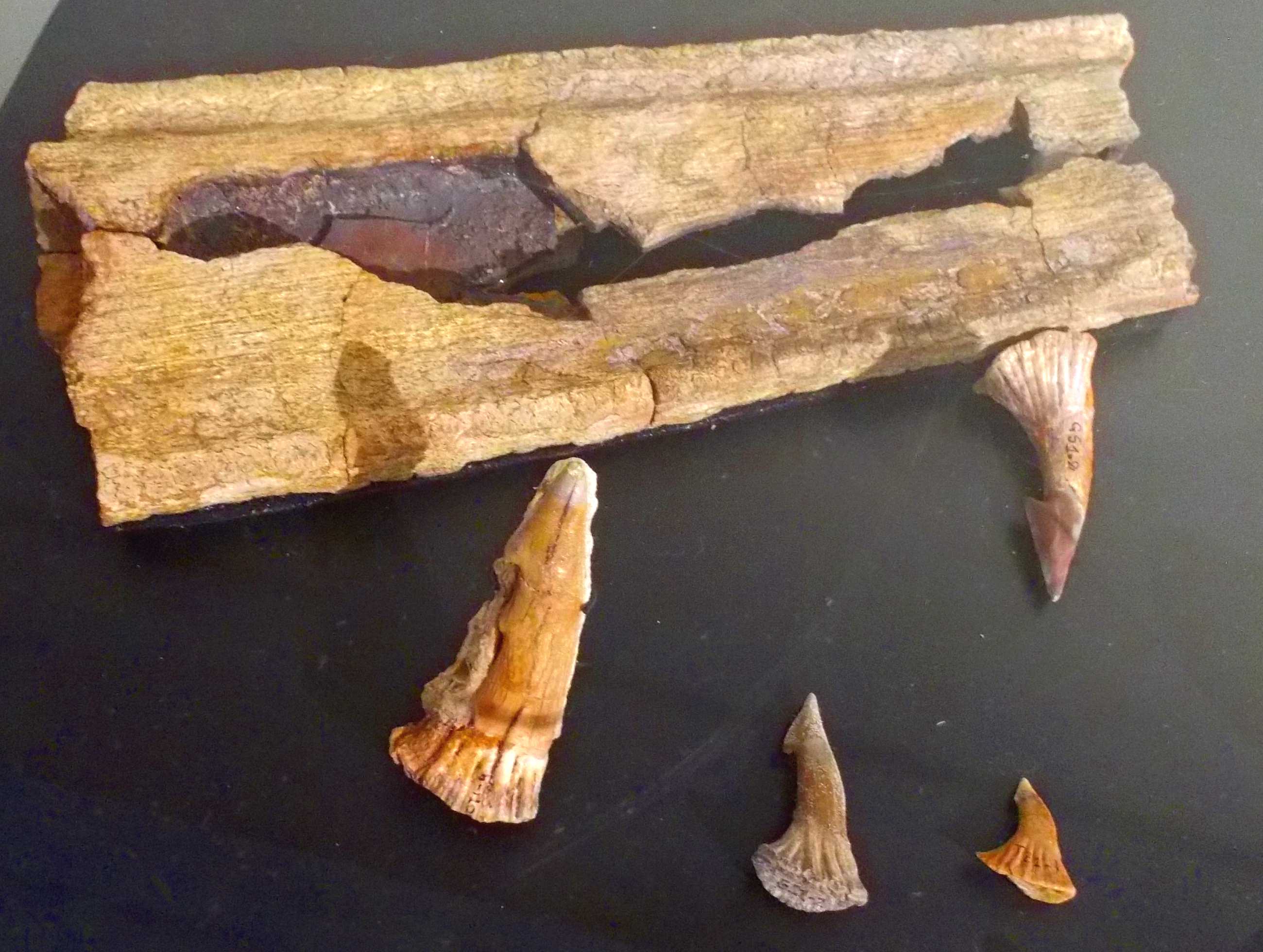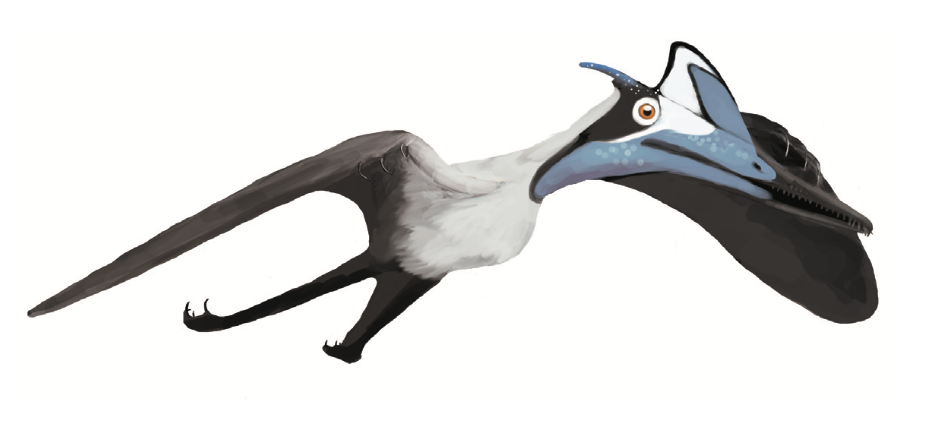|
Alanqa
''Alanqa'' is a genus of Azhdarchoidea, azhdarchoid pterodactyloid pterosaur from the Late Cretaceous period (Cenomanian stage) of what is now the Kem Kem Group of southeastern Morocco. The name ''Alanqa'' comes from the Arabic language, Arabic word العنقاء ''al-Anqa, ‘Anqā’'', for a mythical bird of Arabian culture. Discovery Aided by local villagers, a team of paleontologists had been excavating at several locations in the Kem Kem Beds during April, and November to December 2008, uncovering remains of several different pterosaurs. The material was fragmentary, and the type locality for ''Alanqa'' is Aferdou N'Chaft, near the village of Begaa and to the north-east of Taouz. Description ''Alanqa'' is known only from five fragments of the front upper and lower jaws, and possibly a neck vertebra, representing the single type species ''Alanqa saharica''. Two of these fragments were first described, but not named, by Peter Wellnhofer, Wellnhofer and Éric Buffetaut, Bu ... [...More Info...] [...Related Items...] OR: [Wikipedia] [Google] [Baidu] |
Kem Kem Group
The Kem Kem Group (commonly known as the Kem Kem beds) is a geological group (stratigraphy), group in the Kem Kem region of eastern Morocco, whose strata date back to the Cenomanian stage of the Late Cretaceous. Its strata are subdivided into two geological formations, with the lower Gara Sbaa Formation, Ifezouane Formation and the upper Aoufous Formation used for the strata on the eastern side of the Atlas Mountains (Tinghir), with the Gara Sbaa Formation and Douira Formation used in the southern Tafilalt region. It is exposed on an escarpment along the Algeria–Morocco border. The unit Unconformity, unconformably overlies Paleozoic marine units of Cambrian, Silurian and Devonian ages and is itself capped by limestone platform rock of Cenomanian-Turonian age. It primarily consists of freshwater and estuarine River delta, deltaic deposits. The lower Gara Sbaa Formation primarily consists of Grain size, fine and medium grained sandstone, while the Douira Formation consists of fini ... [...More Info...] [...Related Items...] OR: [Wikipedia] [Google] [Baidu] |
Kem Kem Beds
The Kem Kem Group (commonly known as the Kem Kem beds) is a geological group in the Kem Kem region of eastern Morocco, whose strata date back to the Cenomanian stage of the Late Cretaceous. Its strata are subdivided into two geological formations, with the lower Ifezouane Formation and the upper Aoufous Formation used for the strata on the eastern side of the Atlas Mountains ( Tinghir), with the Gara Sbaa Formation and Douira Formation used in the southern Tafilalt region. It is exposed on an escarpment along the Algeria–Morocco border. The unit unconformably overlies Paleozoic marine units of Cambrian, Silurian and Devonian ages and is itself capped by limestone platform rock of Cenomanian-Turonian age. It primarily consists of freshwater and estuarine deltaic deposits. The lower Gara Sbaa Formation primarily consists of fine and medium grained sandstone, while the Douira Formation consists of fining-upward, coarse-to-fine grained sandstones intercalated with siltstone ... [...More Info...] [...Related Items...] OR: [Wikipedia] [Google] [Baidu] |
Thalassodromidae
Thalassodromidae (meaning "sea runners") is a group of azhdarchoid pterosaurs from the Early Cretaceous (Albian) of Brazil. All known definitive members come from the Romualdo Formation of Brazil, which include the type genus '' Thalassodromeus'', as well as '' Tupuxuara'' and '' Kariridraco''. Proposals of additional thalassodromid genera from the Late Cretaceous are controversial and have not been supported. The classification of Thalassodromidae is quite controversial and disputed. It was initially denominated Thalassodrominae, as a subfamily within the group Tapejaridae. However, opposing studies regarding its placement have argued that its members were more closely related to azhdarchids and dsungaripterids, while also elevating it to family level. Though the relationship with tapejarids remains supported by many studies, it has been proposed that it is preferable to retain them as a distinct family for consistency of communication. Classification The classification of t ... [...More Info...] [...Related Items...] OR: [Wikipedia] [Google] [Baidu] |
Azhdarchid
Azhdarchidae (from the Persian word , , a dragon-like creature in Persian mythology) is a family of pterosaurs known primarily from the Late Cretaceous Period, though an isolated vertebra apparently from an azhdarchid is known from the Early Cretaceous as well (late Berriasian age, about 140 million years ago). Azhdarchids include some of the largest flying animals discovered, but smaller cat-size members have also been found. Originally considered a sub-family of Pteranodontidae, Nesov (1984) named the Azhdarchinae to include the pterosaurs '' Azhdarcho'', ''Quetzalcoatlus'', and ''Titanopteryx'' (now known as '' Arambourgiania''). They were among the last known surviving members of the pterosaurs, and were a rather successful group with a worldwide distribution. Previously it was thought that by the end of the Cretaceous, most pterosaur families except for the Azhdarchidae disappeared from the fossil record, but recent studies indicate a wealth of pterosaurian fauna, including ... [...More Info...] [...Related Items...] OR: [Wikipedia] [Google] [Baidu] |
Alanqidae
Azhdarchoidea ( , meaning "azhdarchid-like forms") is a group of pterosaurs within the suborder Pterodactyloidea. Pterosaurs belonging to this group lived throughout the Early and Late Cretaceous periods, with one tentative member, '' Tendaguripterus'', that lived in the Late Jurassic period. Remains of this group have been found in the Americas, Africa, and Eurasia, suggesting that they probably had a global distribution. Azhdarchoids are generally distinguished from other pterodactyloids by their relatively low arm-to-leg-length ratio, suggesting that they were more proficient in moving on the ground than pterosaurs like ''Pteranodon'' or '' Anhanguera'' (which had very long arms relative to the length of their legs). This has led some researchers to suggest that many azhdarchoids, such as the azhdarchids and dsungaripterids, may have been primarily terrestrial, while retaining the ability to fly when necessary. Classification Azhdarchoidea was named by paleontologist David ... [...More Info...] [...Related Items...] OR: [Wikipedia] [Google] [Baidu] |
Dsungaripteromorpha
Azhdarchoidea (International Phonetic Alphabet, , meaning "azhdarchid-like forms") is a group of pterosaurs within the suborder Pterodactyloidea. Pterosaurs belonging to this group lived throughout the Early Cretaceous, Early and Late Cretaceous periods, with one tentative member, ''Tendaguripterus'', that lived in the Late Jurassic period. Remains of this group have been found in the Americas, Africa, and Eurasia, suggesting that they probably had a global distribution. Azhdarchoids are generally distinguished from other pterodactyloids by their relatively low arm-to-leg-length ratio, suggesting that they were more proficient in moving on the ground than pterosaurs like ''Pteranodon'' or ''Anhanguera (pterosaur), Anhanguera'' (which had very long arms relative to the length of their legs). This has led some researchers to suggest that many azhdarchoids, such as the azhdarchids and dsungaripterids, may have been primarily terrestrial, while retaining the ability to fly when nece ... [...More Info...] [...Related Items...] OR: [Wikipedia] [Google] [Baidu] |
Tupuxuara Longicristatus
''Tupuxuara'' is a genus of thalassodromid pterosaur that lived during the Albian age of the Early Cretaceous, about 112 million years ago. Its remains were found in what is now the Romualdo Formation of the Santana Group in Brazil. ''Tupuxuara'' was named in 1988 by paleontologists Alexander Kellner and Diógenes de Almeida Campos. The name ''Tupuxuara'' means "familiar spirit" referring to a familiar spirit in the mythology of the Tupi people in Brazil. Two species have been named, ''T. longicristatus'', the type species, and ''T. leonardii''. An additional species has been named in 2013, ''T. deliradamus''. However, the validity of this species has been put into question and it may not even belong to ''Tupuxuara''. ''Tupuxuara'' was quite large in size. It had a big crest at the back portion of its head, stemming from the snout. This crest is most likely an indicator of sexual maturity, given that it appears more prominently in mature individuals. The beak of ''Tupuxuara'' ... [...More Info...] [...Related Items...] OR: [Wikipedia] [Google] [Baidu] |
Tupuxuara Leonardii
''Tupuxuara'' is a genus of thalassodromid pterosaur that lived during the Albian age of the Early Cretaceous, about 112 million years ago. Its remains were found in what is now the Romualdo Formation of the Santana Group in Brazil. ''Tupuxuara'' was named in 1988 by paleontologists Alexander Kellner and Diógenes de Almeida Campos. The name ''Tupuxuara'' means "familiar spirit" referring to a familiar spirit in the mythology of the Tupi people in Brazil. Two species have been named, ''T. longicristatus'', the type species, and ''T. leonardii''. An additional species has been named in 2013, ''T. deliradamus''. However, the validity of this species has been put into question and it may not even belong to ''Tupuxuara''. ''Tupuxuara'' was quite large in size. It had a big crest at the back portion of its head, stemming from the snout. This crest is most likely an indicator of sexual maturity, given that it appears more prominently in mature individuals. The beak of ''Tupuxuara ... [...More Info...] [...Related Items...] OR: [Wikipedia] [Google] [Baidu] |
Pterosaur
Pterosaurs are an extinct clade of flying reptiles in the order Pterosauria. They existed during most of the Mesozoic: from the Late Triassic to the end of the Cretaceous (228 million to 66 million years ago). Pterosaurs are the earliest vertebrates known to have evolved powered flight. Their wings were formed by a membrane of skin, muscle, and other tissues stretching from the ankles to a dramatically lengthened fourth finger. There were two major types of pterosaurs. Basal pterosaurs (also called 'non-pterodactyloid pterosaurs' or ' rhamphorhynchoids') were smaller animals with fully toothed jaws and, typically, long tails. Their wide wing membranes probably included and connected the hind legs. On the ground, they would have had an awkward sprawling posture, but the anatomy of their joints and strong claws would have made them effective climbers, and some may have even lived in trees. Basal pterosaurs were insectivores or predators of small vertebrates. Later pte ... [...More Info...] [...Related Items...] OR: [Wikipedia] [Google] [Baidu] |
Azhdarchoidea
Azhdarchoidea ( , meaning "azhdarchid-like forms") is a group of pterosaurs within the suborder Pterodactyloidea. Pterosaurs belonging to this group lived throughout the Early and Late Cretaceous periods, with one tentative member, '' Tendaguripterus'', that lived in the Late Jurassic period. Remains of this group have been found in the Americas, Africa, and Eurasia, suggesting that they probably had a global distribution. Azhdarchoids are generally distinguished from other pterodactyloids by their relatively low arm-to-leg-length ratio, suggesting that they were more proficient in moving on the ground than pterosaurs like ''Pteranodon'' or '' Anhanguera'' (which had very long arms relative to the length of their legs). This has led some researchers to suggest that many azhdarchoids, such as the azhdarchids and dsungaripterids, may have been primarily terrestrial, while retaining the ability to fly when necessary. Classification Azhdarchoidea was named by paleontologist David ... [...More Info...] [...Related Items...] OR: [Wikipedia] [Google] [Baidu] |








